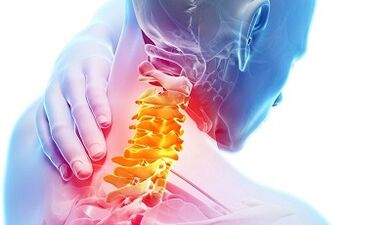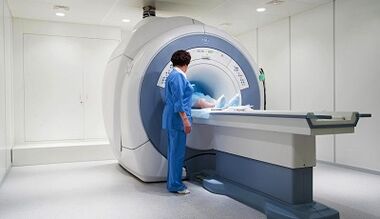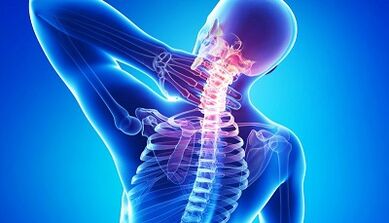Among all the violations of the skeletal muscle system, the second place in terms of prevalence is occupied by cervical back osteochondrosis.Symptoms and treatment of the disease are determined by the stage of its development, so it is so important not to lose signs of a close disease.
Causes and symptoms of osteochondrosis of the cervical spine

Osteochondrosis is called dystrophic changes in the joint cartilage against the background of the intervertebral disc lesion.
The cervical osteochondrosis is characterized by the pathological destruction of the cartilage tissue of the heads that support the head.
Most often, the disease is diagnosed in people aged 30 to 40 years.In developed countries, this or another degree of cervical osteochondrosis is diagnosed in 80% of the population.
The neck is considered the most removable spine.At the same time, there is an insufficient amount of muscle around the neck that can offset the loads on the back.Therefore, most of the loads fall on the intervertebral discs that play the role of absorbing shock.
As a result, the discs are tired, dried and flattened, osteochondrosis develops.
The reasons that contribute to the emergence of pathology lie not only in anatomy but also in human behavior:
- Soweity and static, sitting work - on the computer, driving a car, in the office;
- Excess weight;
- Great physical exercises;
- smoking;
- Improper food;
- weak physical form;
- Spinal injuries.
Extra provocative factors in the development of osteochondrosis are: flat feet, soft mattresses and pillows, the habit of dressing a bag on shoulder, hypothermia and stress.
How the disease manifests
At the beginning of the disease with respect to its development, only the neck flow, which is usually not given attention.With the progress of the pathology, the number and intensity of manifestations increases.
Characteristic symptoms of cervical osteochondrosis occur:
- pain in the back of the head, at the base of the neck, giving to the limbs;
- crisis and pain when turning your head;
- numbness or tingling between shoulder blades and neck base, burning, a feeling of discomfort and stiffness;
- headaches, migraines, dizziness;
- Weakness, fatigue.
Secondary symptoms are considered a decrease in vision, hearing, memory problems, sleep disturbance, inattention, distraction, pressure.
Osteochondrosis syndromes of the cervical spine

Doctors classify signs of osteochondrial processes as syndromes associated with a certain type of spine.
Stenosis.It develops against the background of the intervertebral disc herniation and is associated with a violation of blood circulation and the growth of bone tissue.Is manifested by the numbness of the limbs.
Reflex and irritating syndrome- a consequence of compression of the vertebral artery with the bending of the neck and impaired behavior.It manifests itself in severe paroxysmal pain in the occipital part with gradual spread in the areas around the forehead.
Rook syndrome.Observed when flattening the spinal roots - the consequences of a hernia.At the same time, sensitivity in the affected areas decreases, and motor activity becomes limited.It can be associated with the development of speech, snoring, damaged odor, a decrease in the sensitivity of the muscle of the tongue.
The degree of development of cervical osteochondrosis
The complexity of the process process is determined by the condition of the pulpoosis nucleus that fills the vertebral space.
Degenerative lesions of the cervical region are conditionally divided into three stages:
- At firstThe intervertebral disc is compacted.The bead grates are growing.Muscle stiffness appears, but their mobility does not change.Small edema and pain when turning your head are possible;
- The second.It develops against the backdrop of the first phase of the disease if the treatment of osteochondrosis of the cervical spine was absent or performed incorrectly.The intervertebral holes are narrowed, the height of the intervertebral discs becomes less due to their flattening.Pinches nerve roots.The patient feels a painful pain;
- Third.Acques in the fibrous ring surrounding the intervertebral disc leading to the rupture of its capsule and deforming muscle tissue.The stability of fixing the pulpo nucleus inside the intervertebral disc is violated.Intervertebral hernia develops.It is characterized by acute neck pain, numbness of the tongue, edema, mobility restriction, spinal cord bending.
The exact position of the vertebrae of the cervical region determines the functionality of the visual and auditory nerves, nose, lips, mouth, throat, teeth, facial nerves, pituitary, brain, parasympathetic nervous system, neck muscles and forearm, thyroid gland, elbow and shoulder joints.
Diagnostic methods

Accurate determination of the cause of osteochondrosis development allows you to influence the disease.Preliminary diagnosis is indicated after initial examination by the doctor.
The patient's complaints about the nature of the pain syndromes are taken into account, as well as the information obtained during the spine examination in different positions.The study of cervical separation allows you to determine the presence of seals and deformities.Moreover, attention is paid to the patient's muscle tone and motor skills.
Doctors receive full diagnostic information using studies such as:
- Radiography.The procedure allows you to evaluate the condition of the beads in two projections - straight and side.The result is the determination of damage, salty deposits and compressed formations;
- Magnetic Resonance TomographyIt allows you to create not only any spinal pathology but also the degree of severity.By means of an MRI, a physician can evaluate the condition and level of nerve ending, blood vessels and intervertebral discs;
- Calculated tomography- Digitalization of information obtained from X -Ray radiation.
In the presence of dizziness, an additional study of structural change in blood vessels through domorography, angiography and duplex scanning may be needed.
How to treat cervical osteochondrosis?
After making an accurate diagnosis and clarify the causes of the development of the disease, the neurologist determines how to treat cervical osteochondrosis.
Optimal results are brought in complex therapy, which provides for the use of several methods.Protocols include the effects of medication, hardware procedures, exercise therapy and therapeutic massage.
Treatment with medication

In each individual case, the choice of medicines occurs individually.It depends not only on the severity of the pathology but also on the specific characteristics of the patient's body.
Fixed drug treatment drugs:
- anti -inflammatory drugs - tablets that relieve pain and inflammation;
- Chondroprotectors - medicines that activate the regeneration of cartilage tissue;
- external use - ointments and gels that stop pain and inflammation;
- A complex of vitamins to support the body and stimulate its restoration.
In the first stage of the therapeutic effect, it is possible to increase pain syndrome - this is the reaction of the muscle system.Physiotherapeutic procedures are used to reduce the discomfort and improve the treatment results.
Physiotherapy
Physiotherapy implies the effect on the cause of the disease using special equipment - electrophoresis, electrical stimulation of tissue.The use of low -frequency currents improves blood circulation in the affected areas, relieves edema and pain, and at the same time increases the effectiveness of medical effects.
The minimum hardware treatment course is 10 sessions.
Massage for cervical osteochondrosis at home
Manual therapy is a productive way to influence the affected areas in the house.With the help of massage, pinching, muscle cramps and pain is eliminated, blood circulation improves and compression of the nerve roots is reduced.
Thanks to massage, metabolism improves and spinal tissue are restored.
Physical media education for osteochondrosis of the cervical back
The best method to restore the functionality of the organs of the muscular system and the prevention of relapse is the physical education of physiotherapy for osteochondrosis of the cervical region.The procedures are prescribed after completely relieved pain and inflammatory processes.
The main types of exercise therapy:
- Medical gymnastics;
- walking by dose;
- classes in simulators;
- swimming.
In order for exercises for cervical osteochondrosis to bring about the expected results, classes must be kept under the supervision of competent specialists.
Folk remedies
Complete elimination of cervical osteochondrosis using traditional methods of medicine is impossible.On the other hand, the use of popular remedies allows you to improve the patient's condition, relieve inflammation, reduce pain and strengthen immunity.
On average, the therapeutic period with cervical osteochondrosis lasts up to three months.If conservative treatment has not brought the expected results, surgery is used.
Why is cervical osteochondrosis dangerous?

Pathologies in the neck pose a serious threat to all human health.Since the neck connects the head to the body, in this part of the spine has all important biological communications - the arteries that nourish the brain, nerve canals.
Anydo change in the functionality of the cervical region includes the consequences in the form:
- Disordisms of blood circulation and brain nutrition.As a result, hypertension, respiratory system pathology and cardiovascular system, VSD, impaired coordination develops, hearing problems, vision and speech develop;
- Vertebral artery syndrome.The pathology develops against the background of squeezing a vessel that feeds the cerebellum and an extended brain.The development of cervical osteochondrosis can cause ischemia and stroke;
- Radiculopathy - damage to the nerve roots, increased bone tissue in the vertebrae, as a result of which partial or complete loss of mobility occurs.
The most dangerous compression of the spinal cord, which is located inside the spine.Such a pathology leads to a rupture of the spinal cord shell and causes paralysis.In particularly severe cases, cervical osteochondrosis ends fatal.
PREVENTION
Even after a complete recovery, the disease can return again if the patient does not review his lifestyle - the way of working and resting, habits, food.
As a precautionary measures, neurologists recommend paying attention to the following points:
- The hardness of the mattress.The ideal option is an orthopedic mattress and a low pillow;
- A visit to the sauna is needed for complete relaxation and removal of muscle cramps;
- Hot day shower is a good tool to improve blood circulation in the neck;
- Swimming, walking, stimulates blood circulation, strengthens the spinal muscles;
- Proper nutrition is the rejection of products that slow down metabolism: fatty, fried, sweet, smoked, flour and alcohol.Gelatin dishes, dairy products, nuts, vegetables, white meat, seafood are recommended.

In everyday life, great physical exercise, sharp head curves, prolonged landing or being in a static position should be avoided.In addition, it is desirable to use chairs that provide head and back support.
The active position of life, healthy nutrition and breakfast exercises are simple but effective ways to avoid most of the diseases and live a long life without pain and discomfort.


















